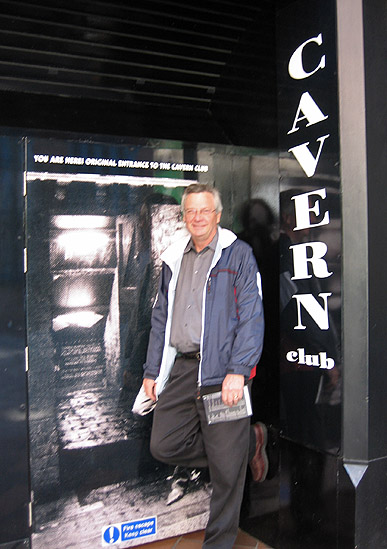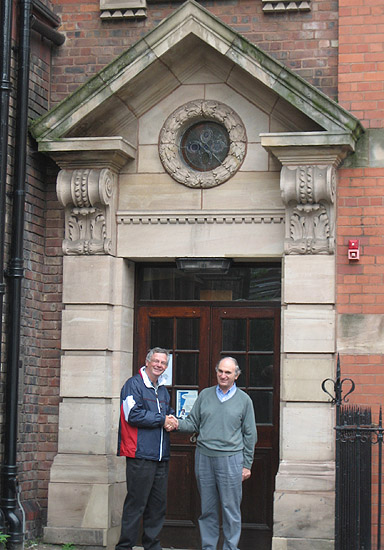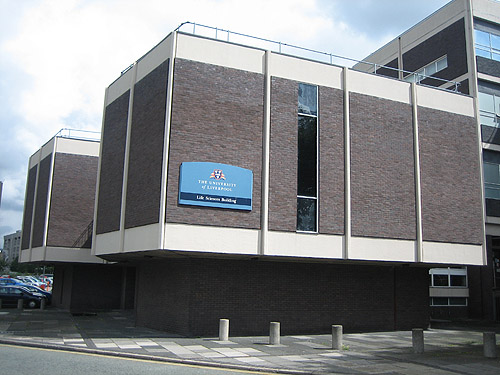 |
 |
Chair's
Pilgrimage to the Department of Biochemistry
University
of Liverpool
|
 |
Thousands
of pilgrims travel to Liverpool, England every year. Most come to
visit the birthplace of the Beatles. They arrive at John Lennon
“above us only sky” Airport. Top stop is the site of
the Cavern on Mathew Street, the dark, sweaty club where the Beatles
got their start. Penny Lane, Strawberry Fields, St. Peter’s
Church where John and Paul first met, and their childhood homes
are all on the “Magical Mystery Tour”.
Site of
the original Cavern Club on Mathew Street. |
|
Liverpool
is designated as a "World Heritage City" by UNESCO. Many
come to admire the grandeur of the waterfront, the Anglican and
Catholic cathedrals, or the old masters at the Walker Art Gallery.
The City of Liverpool celebrates its 800th anniversary in 2007,
being given city status by King John of Magna Carta fame in 1207.
Others come
to visit Anfield, home of the Liverpool Football Club – England’s
most successful football club, winners of the 2006 FA Cup. Everton
fans head to Goodison Park. No love lost between the Reds and the
Blues.

The
"Three Graces" - The Royal Liver Building, The Cunard
Building, and The Port of Liverpool
provide Liverpool with its famous skyline.
|
|
My
journey was to visit the Department of Biochemistry at the University
of Liverpool. The department was founded in 1902, making it the
oldest biochemistry department. Our department, founded in 1907
is the second oldest, ahead of London (1912), Cambridge (1924),
Queen’s (1924) and University College Dublin (1932).
Professor Huw
Rees, Professor of Biochemistry was my host. I found Huw toiling
away in his cramped office with a grant application for studentship
support. I told him that I was on a pilgrimage from Canada to visit
the oldest Biochemistry Department and that we were the second oldest
and about to celebrate our 100th anniversary. Huw joined the Biochemistry
Department in 1966 and was pleased to tell me about some of its
history and to give me a tour.
Huw
Rees and Reinhart Reithmeier outside the Johnston Laboratories (1903),
first home of the Biochemistry Department. |

|
| The
Department of Biochemistry at Liverpool was created in 1902 with
Dr. Benjamin Moore as holder of the first chair. The chair was named
in honour of William Johnston, a local ship-owner who donated £10,000
to create the department and construct a building.
Moore and another
Liverpool biochemist, Edward Whitney, founded the Biochemical Journal
in 1906, a year after the Journal of Biological Chemistry. The oldest
biochemical journal, Hoppe-Seyler’s Zeitschrift für Physiologishe
Chemie, started in 1877. The Biochemical Journal was taken over
by the Biochemical Society in 1913.
During the 60’s
expansion, the Department moved into the new Life Sciences Building.
In 1996 the Department along with Environmental & Evolutionary
Biology and Genetics & Microbiology merged to form the School
of Biological Sciences (http://www.biolsci.liv.ac.uk/).
In 2002 the Department celebrated its 100th anniversary with an
international symposium on signalling.

The Life Sciences Building, opened in 1969.
|
|
In
2004 the Department moved into the Biosciences Building, an open
concept structure that houses state-of-the art facilities for proteomics,
genomics, imaging, microarrays, bioinformatics, and an NMR Centre
for Structural Biology, the centerpiece being an 800 MHz Spectrometer.
The current Chair of Biochemistry is Professor Stephen Edwards,
a molecular immunologist interested in neutophil function. We have
connections as our own Dr. Robert Painter, Professor Emeritus was
a graduate of the Department of Biochemistry at the University of
Liverpool.
The
Biosciences Building, opened in 2002. |

|
|
What struck me during my visit was how similar the history of the
two departments has been. We were created around the same time,
survived difficult times during war and recession, moved into new
buildings during the 1960s, and have expanded our mandate to include
much more than traditional biochemistry, as biochemistry has become
the fundamental molecular life science. It’s been a “Long
and Winding Road” over the past 100 years. Who knows where
the road will take biochemistry over the next 100 years!
|
|
 |





















